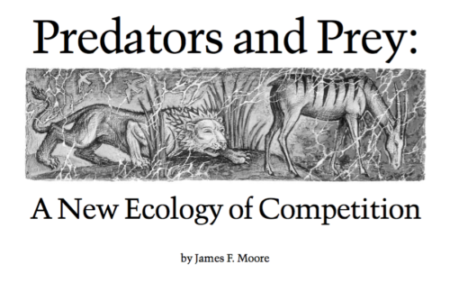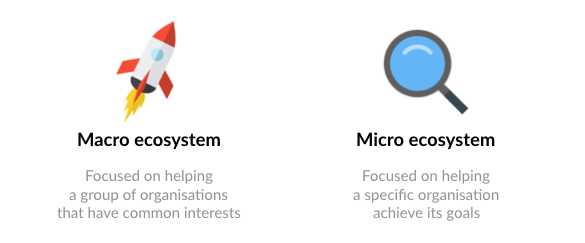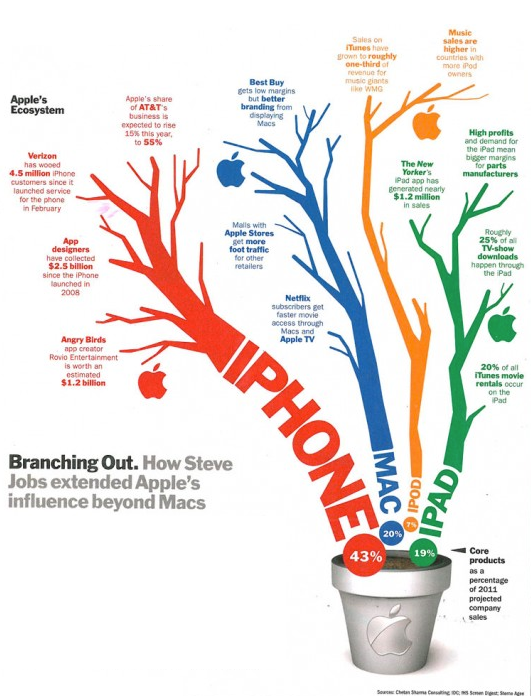What’s a Business Ecosystem: How To Build or Join One?
Business ecosystem is an important concept in strategy.
Why?
That’s because being part of an ecosystem encourages both innovation and growth.
(1) It helps create new value propositions;
(2) It’s a springboard for reaching more customers.
In this article, you’ll learn how you can implement the concept of ecosystem into your business model.
Mục Lục
What’s a business ecosystem?
Let me first explain what business ecosystem means.
Business ecosystem is the idea that a business—like any animal—is part of a broader system.
James F. Moore coined the term “business ecosystem” in an HBR article, Predators and Prey: A New Ecology of Competition.

Here is how he describes the concept of “business ecosystem”:
“In a business ecosystem, companies co-evolve capabilities around a new innovation: they work cooperatively and competitively to support new products, satisfy customer needs, and eventually incorporate the next round of innovations.”
Like in any biological system, businesses “co-evolve”.
They benefit from the existence of other businesses.
In this example, Harvard Professor Marco Iansiti shows the breadth of a business ecosystem for a company:
“Your own business ecosystem includes, for example, companies to which you outsource business functions, institutions that provide you with financing, firms that provide the technology needed to carry on your business, and makers of complementary products that are used in conjunction with your own. It even includes competitors and customers, when their actions and feedback affect the development of your own products or processes. The ecosystem also comprises entities like regulatory agencies and media outlets that can have a less immediate, but just as powerful, effect on your business.”
Your own business ecosystem goes beyond suppliers and customers. It encompasses all the organisations that can impact your strategy, your sales, your products, or your people.
Why it matters for your business?
The concept of business ecosystem is important.
It includes all the organisations that can help you:
- Create awareness of specific needs and desires
- Reach new customers
- Build new products and services
- Make operating a business easier and cheaper
- Work with regulators
- Educate your audience
- Hire the right talent
It’s the “Partnership” box of the Business Model Canvas.
(For more explanations of Strategyzer’s Canvas, read this article).
Be aware of the different types of business ecosystems
Business ecosystems show up in various ways.
We can look at a business ecosystem from a macro perspective (country level or industry level) or a micro perspective (company level).
Business ecosystems can also be local (e.g. the neighbourhood of a city) or global (e.g. Linux and all the ecosystem around it).

Macro-business ecosystems
A macro-business ecosystem is led by a group of organisations.
It shows up through initiatives such as industry standards (e.g. Bluetooth) or lobbying to encourage a change of regulations.
Their overarching goal is broad and focuses on helping an industry or a group of organisations that have a common interest.
Micro-business ecosystems
At a micro level, you get two main sorts of ecosystems:
A captive business ecosystem = one company leads the all network of people and organisations involved
The big decisions about the ecosystem are centralised.
For example, Apple leads a large ecosystem of suppliers, app developers, hardware add-ons companies, retailers, and users. Most of what happens within the ecosystem is guided by frameworks that Apple creates (e.g. validating the distribution of an app on the AppStore).

There’s another type of business ecosystem.
A decentralised business ecosystem = the ecosystem is self-regulated
For example, Ethereum is run on a decentralised, consensus-based governance.
Decentralised business ecosystems tend to be organised around a specific open source technology. This has been the case for the Bittorrent ecosystem or the different Blockchain ecosystems.
Inspiration: Examples of business ecosystems
Building or taking part in a business ecosystem is a strategic choice.
It’s an important element that influences your business model.
There are many ways you can make it happen.
The digital business ecosystem
Building a digital business ecosystem can encourage innovation.
WordPress is a great example of that.
The ecosystem benefits from having a network of hundreds of thousands developers who build plugins and themes to help users create websites.
Example:
For example, at GoudronBlanc, we use WordPress + WooCommerce to run our e-commerce shop. Through WordPress, we’ve been using many digital products such as Stripe, Yoast, and Google Analytics.
– For us—users—it makes it cheaper and easier to build an e-commerce shop.
– For the developers, it makes easier to reach new users.
The strength of WordPress is this strong ecosystem of developers and users who benefit from each other’s involvement.
The marketplace ecosystem
Creating a marketplace is a way to provide a large range of products—benefiting from the long tail.
Etsy or eBay are quintessential examples of that. You can find nearly everything on these marketplaces.
How does that work?
Marketplaces manage an ecosystem of buyers and suppliers:
– Suppliers benefit from tools and distribution channels that help them sell products and services.
– Buyers benefit from the breadth of the catalogue or the curation that the marketplace provides.
Example:
As an example, I used Leanpub (an e-book marketplace) to launch The Value Mix.
The reasons?
(1) Leanpub gave me the tool to publish the book like a software. I can release new versions of the book whenever I improve it.
(2) It also gives me access to a customer base of readers who are interested in books about strategy, innovation, and entrepreneurship.
This is an example of how an author or a freelancer can leverage an existing business ecosystem.
The local business ecosystem
There’s one thing that’s fascinating about local business ecosystems.
How improving the supply in a location can generate more demand.
Indeed, the more a local area has to offer the more people it attracts.
Example:
A good example of that is the High Line.
This project helped develop a local area in Manhattan, NYC. It turned an outside railway into green space.
The park attracts now thousands of people every weekend. This constant flow of people has encouraged entrepreneurs to build coffee shops, stores, residential buildings, etc.
The best here?
Each store or café is likely to attract even more people. The growth of ecosystem contributes to the economic development of the area.















![Toni Kroos là ai? [ sự thật về tiểu sử đầy đủ Toni Kroos ]](https://evbn.org/wp-content/uploads/New-Project-6635-1671934592.jpg)


